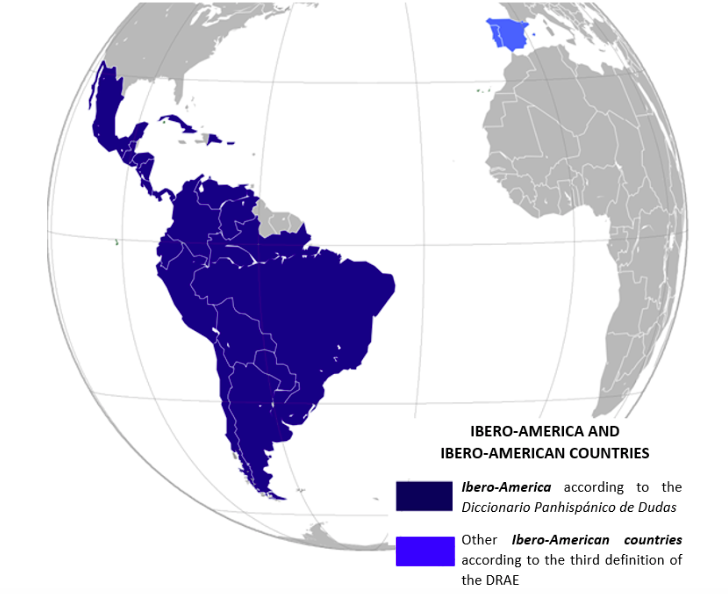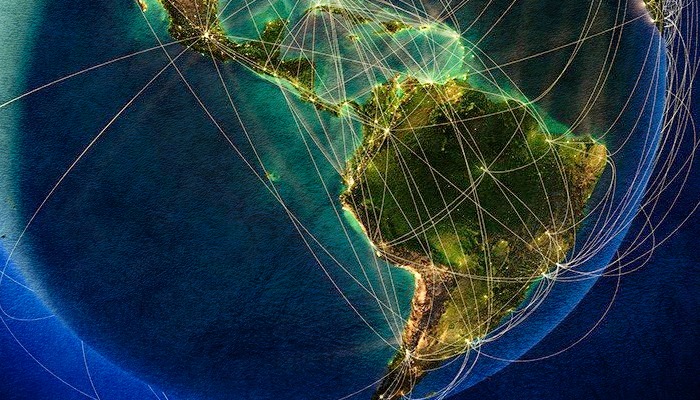PART 1: ANTECEDENTS, POTENTIALITIES AND WEALTH
A brief history of the balkanization of Ibero-America.
First of all, I want to clarify why I will be using the term “Ibero-America” instead of “Latin America.” The region in question stretches from northern Mexico to Ushuaia in southern Argentina, and is made up of a majority of Spanish and Portuguese speakers. The denomination “Latin America” is a nineteenth-century French invention that, through focusing on language, attempts to remove the symbolic predominance and cultural weight that countries such as Spain and Portugal have in the region.

Wikimedia commons
It is necessary to differentiate between overseas territories and colonies. Colonies are peripheral territories administered by a metropolitan center, where the inhabitants of the periphery are not subject to the same rights and statutes as those in the center (Such as the territories formerly controlled by France, United Kingdom, etc.) In Ibero-America, both Spain and Portugal consider their land holdings as ‘overseas territories’ where citizens have the same rights on both sides of the Atlantic. In Spain’s case, under the 1512 “laws of Burgos”, the same rights and protections were established for natives as citizens living in the center. In 1812, the Spanish constitution further clarified what was already a fact: The Spanish nation encompasses Spaniards in both hemispheres. All people born under Spanish dominions were Spaniards, as were their children. The same is true for Portugal: the territory was never designated as a colony, and its inhabitants all had the same rights (naturally, with the exception of slaves).
Establishing this difference is critical. While the United Kingdom rewarded characters such as Marshal Jeffrey Amherst for carrying out the genocide of the Delaware natives in Oklahoma, Spain sought to protect indigenous communities. The status of England’s colonies barely changed over the centuries: the people living in these territories never had the same rights as those born in the metropolis. This was the case until 1982 for those living under British rule in the Falklands.
Spain and Britain have been involved in numerous conflicts since the sixteenth century, but things really heated up during the mid-eighteenth and early nineteenth centuries. This is evident in England’s numerous failed invasions of Spanish territories during this period, such as Cartagena de Indias 1740, Santa Cruz de Tenerife 1797, Puerto Rico 1797 and Buenos Aires in 1804 and 1806. The British Empire eventually understood that it could not defeat Spain militarily and undertook a new strategy to weaken it from within.
During the Napoleonic wars, the United Kingdom used various civil organizations linked to Freemasonry to take advantage of Spain’s internal weakness, coupled with the strife of the wars for independence that took place between 1808 and 1825 in Ibero-America. During this period, Spanish territories that had been politically and economically interconnected for centuries were broken up by separatist movements. The massive territory was divided into more than twenty countries where imperialism, mainly British, was able to generate a huge amount of revenue by introducing its products and putting the newly independent states into heavy debt.
Decades later, the final blow was delivered by the United States during the 1898 Spanish-American War, when the Americans usurped the territories of Cuba, Puerto Rico, the Philippines and the island of Guam. The United States’ imperialist act was justified following a false flag attack, where the USS Maine was intentionally sunk in order to push the population into accepting war with Spain. By this point, the citizens of these territories already had Spanish passports, but without protection, the US engaged in a near genocide of the Philippines that left over a million dead. The Philippines did not manage to obtain independence from the US until the mid-twentieth century, while other sites such as Puerto Rico and Guam are still under Washington’s dominance.
After the disappearance of Spanish rule in the American Continent, various wars took place between people that had formerly lived fraternally, often in conflicts that were artificially manufactured from abroad. The decline and loss of Spanish and Portuguese dominance coincided with the rise of other powers such as the United Kingdom, France and the United States, while the standard of living of the Ibero-American people declined significantly.
What attracted imperialist powers to Ibero-America ? Wealth and potential
Ibero-América currently forms a community of more than 600 million inhabitants who occupy an area of around 20 million km2. The area is also rich with natural resources. More than half of the area is divided between Brazil, Mexico and Argentina, which make up more than half of the population (and GDP) of the entire region.
Ibero-America is saturated with strategic natural resources, and is the largest exporter of much of them. For instance, Argentina has one of the largest reserves of liquefied Natural Gas; it also has an abundant amount of lithium and rare earth metals. Chile is the world’s leading copper exporter, and also boasts large deposits of lithium and other precious metals. Bolivia and Peru are much the same. As is well known, Venezuela has a great deal of oil, as does Brazil, along with numerous others types of minerals and metals. Wherever you look in Latin America, you find an abundance of fossil fuels and minerals that are highly valued in the international market. These resources are essential for industrialized countries, which is why China and the United States have become the parties most interested in the area’s natural wealth.
On top of these forms of natural wealth, UNASUR (the Union of South American Nations) is the largest food exporter in the world. Argentina, for example, has a population of barely 43 million inhabitants but is able to produce enough food for more than 400 million. Brazil, although it has a much larger population, is also a large exporter of food internationally. Paraguay, a small country with no access to the sea, has only 7 million inhabitants yet it produces enough food for almost 10 times its population. Generally speaking, Ibero-American soil is very rich for agriculture and livestock. As the world’s population increases, food is becoming a more and more critical resources, particularly for heavily populous countries such as China.
What about Antarctica?
Antarctica is another important issue closely related to Ibero-America. It must be taken into account that despite being considered today as an “international territory”, many countries on the South American continent claim Antarctic territory as their own. Just as Russia, Canada, the United States and Denmark have claimed the North Pole under the “theory of polar sectors,” countries such as Argentina and Chile relied on the same idea to claim territory in the Antarctic, even recognizing each other’s claims in 1948. Kingdom United has also claimed a portion of Antarctica, superimposed over Argentina and Chile, adducing its supposed rights over the Falkland Islands that the United Kingdom stole from Argentina in 1833.
.

https://www.worldatlas.com/webimage/countrys/an.htm
Antarctica has an area of about 14 million km2, and is subject to heavy water condensation, a factor which distinguishes it significantly the north pole. Antarctica is the largest water reserve in the world accumulating approximately 90% of the world’s ice, which makes up 80%-90% of the planet’s freshwater. It is also laden with important mining resources such as coal, iron, antimony, chromium, molybdenum, diamonds, uranium, gold and oil. The area’s coal deposits are of particular note. The trans-Antarctic mountain range has the largest coal layer in the world and quite possibly also has large reserves of hydrocarbons in its underwater platforms. Other natural resources are abundantly found in the Southern ocean that surrounds the continent such as algae, krill, mollusks, mammals, seabirds and more than a numerous species of fish. The Antarctic may be subject to discussions of sovereignty as its ecosystem factors into geopolitical motivations and interests in the region.
Conclusion part 1
Ibero-America is a massive territory that, despite sharing a common language, history, culture and religion (for the most part) is artificially divided into more than twenty countries. After having been united for more than 4 centuries, its fracture resulted in indebtedness and economic stagnation despite centuries of stability under Spain and Portugal. This could not have happened without intervention by foreign powers, such as the United Kingdom, who eventually took control over these territories in order to exploit them economically. This relationship continued well into the era of financial capitalism, a relationship well elucidated by textile entrepreneur Richard Cobden in 1804 when he declared that “England will be the workshop of the world and South America his farm.”
The issue is multifaceted and will require further analysis. In the second part of this article, I will discuss the failed attempts at forming a union and help deepen our understanding of the strategic positioning of foreign powers in the territory.

















Leave a Reply